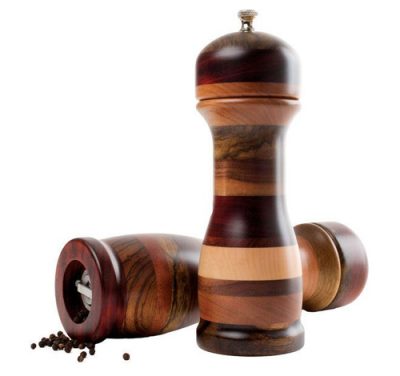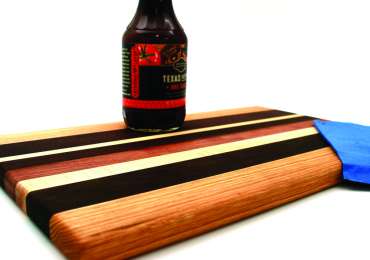Answers to the questions we are asked most often.
Q: How do I adjust and fill my wood pepper mill or salt grinder?
A: Filling the mill is very simple- just unscrew the chrome knob on the top and pull the top straight up, reverse for reassembly. To adjust the grind after filling, tighten the chrome adjuster knob for a finer grind. For coarser grind, loosen the knob a little and push down. Also note, for best grinding performance turn the top in a back and forth direction. If corns get stuck in the grinder give the mill a couple shakes to loosen the peppercorns.
 Q: What’s the difference between a pepper grinder mechanism and a salt grinder mechanism?
Q: What’s the difference between a pepper grinder mechanism and a salt grinder mechanism?
A: Both grinder mechanisms are extremely durable (professional grade) and guaranteed for life. The difference between them is in the material- the pepper mechanism is stainless, the salt is ceramic. This is because salt would eventually cause corrosion to the stainless. So, do not use salt in the pepper grinder, or vice versa.
The ceramic grinder for the salt functions in the same manner as the pepper. An ‘S’ chrome knob is placed on top. It is intended to be used with sea/rock salt, not really for small crystal (standard) salt. Standard small crystal salt would just sift through the bottom of the mechanism without grinding. So by all means do use the salt grinder with its intended sea/rock salt. Also, as an additional tip for the best grinding efficiency and to reduce chances of clogging turn the head back and forth.
A: The most common statement we hear about other mills is it will not grind anymore. This is why Gregg uses the best mechanism he can find and we love that they are manufactured in the United States.
The mechanisms we use are made by Chef Specialties. Located in U.S., Chef Specialties have been manufacturing grinder mechanisms since 1940. Their grinder mechanisms are the most frequently demanded by professional and amateur chefs alike.
Best of all, they come with a lifetime guarantee.
Q: Are there specific cleaning or conditioning requirements for G3’s wood pepper and salt grinders?
A: Cleaning and conditioning are simple. Use mild soap and water on a damp soft cloth to wash it, and of course, do not submerge it in the water. You can also use any good furniture wax like Johnson’s Furniture Wax, but do not use automotive wax. Automotive wax contains abrasives that will scratch the finish on the wood pepper mills and grinders. Trust us our wood pepper grinders and salt mills are made to be used and meant to last for generations.
Q: Why are the pepper mills and salt grinders so expensive?
A: Our philosophy is, “why make it ordinary when you can make it extraordinary.” It is functional art. The craftsmanship is really what you are paying for. Every place you see a different color is a different piece of wood that is hand cut and hand glued together to assemble a rough shape. The blank is turned on a lathe. The finished piece is then sanded and coated several times with an extremely durable and expensive finish much like an epoxy or automotive finish, but specifically for wood. True American Craftsmanship! We don’t try to compete with any box store labels. Our thoughts are always attentive to the details. Step forward and bring something different to the table. Something extraordinary!
You cannot think of it as buying an expensive pepper mill or salt grinder. You have to look at it as buying functional pieces of art for your kitchen or dining table that can be used every day. Why have a boring pepper mill?
Q: What is the advantage of wood cutting boards and wood chopping blocks over plastic or glass types?
A: Bacteria has a tougher time surviving on wood boards. Research has shown that bacteria, such as the salmonella often found on raw chicken, will thrive and multiply if not removed from plastic boards. On wood boards, whether they are new or have been used for years, the bacteria dies off within 3 minutes. Researchers theorize that the porous surface of the wooden boards deprives the bacteria of water, causing them to die. It is not recommended that the same cutting board be used for raw meats as used for other foods such as vegetables, cheeses or breads. Also, your knives will dull much faster on a glass or plastic board than a wood board.

Q: How do I take care of my wood chopping block or wood cutting board so it keeps its appearance?
A: The answer is, oil often, sometimes as frequently as once a week or more. It is dependent on how much you use and wash your board. I frequently suggest applying a good wet coat before going to bed, and in the morning wipe off any excess with a dry paper towel. You’d be surprise how little if any oil is left on the surface in the morning. If you allow your board to become dry it may begin to crack and/or warp. This is not a defect, but rather the result of low relative humidity. If I sound repetitive, it’s because I cannot emphasize enough the importance to oil, oil, oil. For additional protection and moisturizer, you can use Bee’s Oil. Bee’s Oil is a food safe mixture of food safe oils and bees wax. It will help restore and maintain a soft sheen. Bee’s Oil can be purchased from Holland Bowl Mill at www.hollandbowlmill.com
Unless the board has feet, keep one end propped up or stand the board on its side when not in use for maximum air ventilation. When a board is left flat on a counter, both sides of the board will not be exposed to the same humidity level and may cause it to warp, even if the board was dry to the touch when laid flat.
If your cutting board shows significant signs of wear, it can be sanded and re-coated, as described above. Once cutting boards (plastic and wood) become excessively worn or develop hard-to-clean grooves, they should be discarded, although, wooden boards can typically be resurfaced with the proper equipment.
Q: What is the difference between wood end grain chopping blocks and wood face grain cutting boards?
A: The majority of wood cutting boards you can buy today are edge or face grain design, meaning you are looking at the wood grain along its length (direction of growth). With end grain boards (chopping blocks,) you are looking into the end of the grain, as if you are looking down into the top of a tree stump.
Both designs are just as functional and food safe, but end grain boards are far more durable and friendlier to your knife. The old fashioned butcher blocks were always end grain design (chopping block) for a reason: to keep the knives much sharper. Instead of crushing against the wood fibers, the blade goes between them much like cutting into the end of a firm brush. In a face grain board, think of wood fiber much like hair, as you cut across you break the fiber and those fibers start to pop up from the board surface. With proper care, a face grain board will last many years, but an end grain board will last a life time.
Guarantee from Gregg Palm: “Although I can’t guarantee the effects of Mother Nature, I do guarantee my workmanship.”
